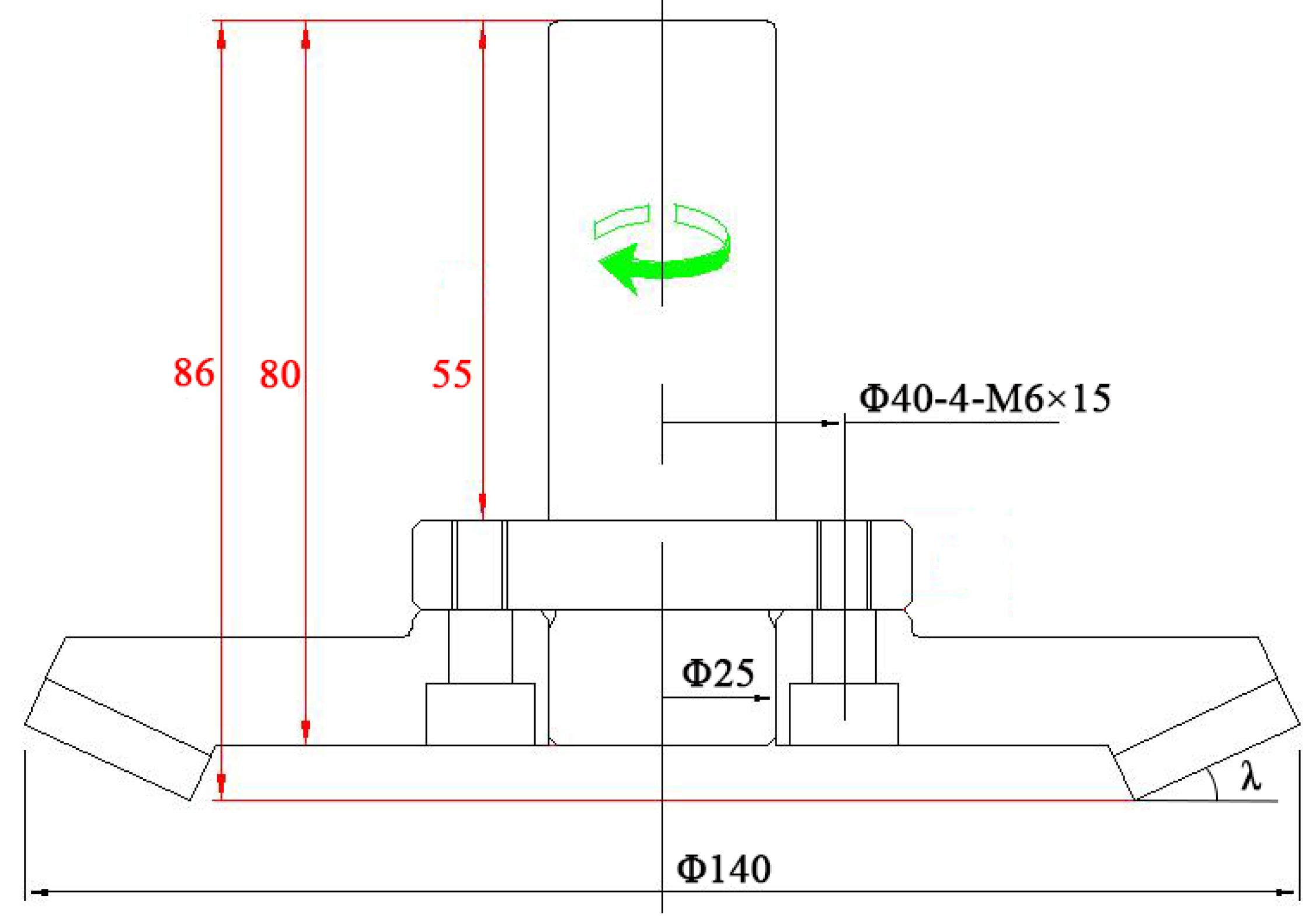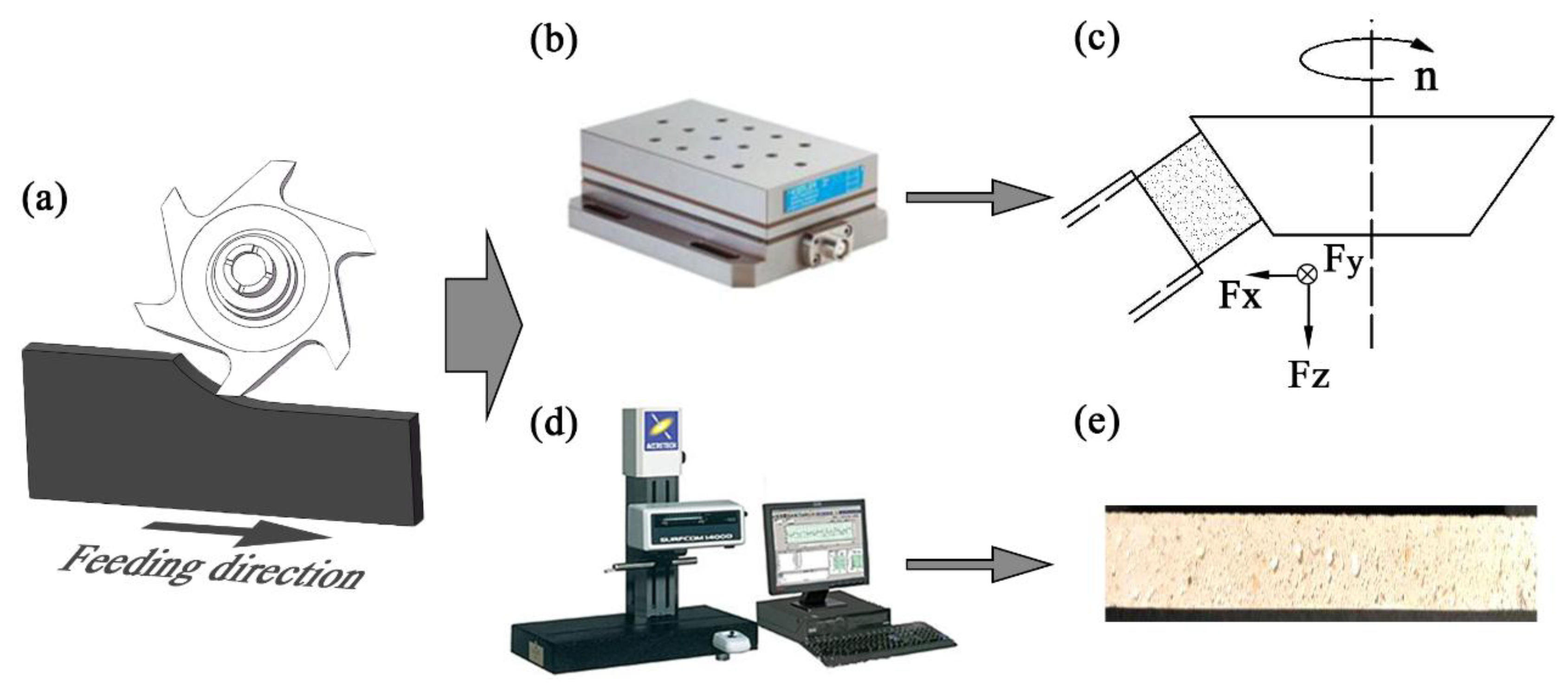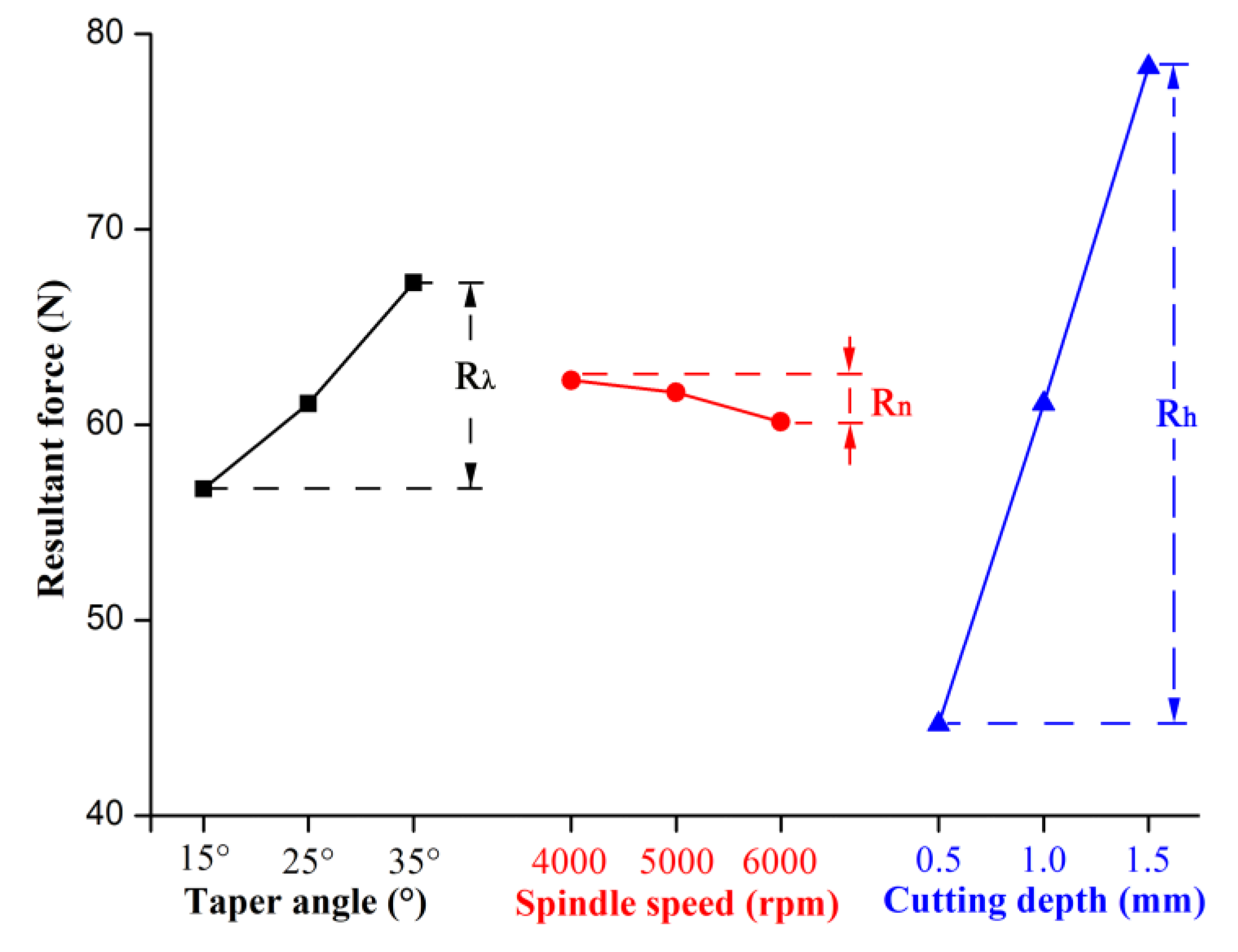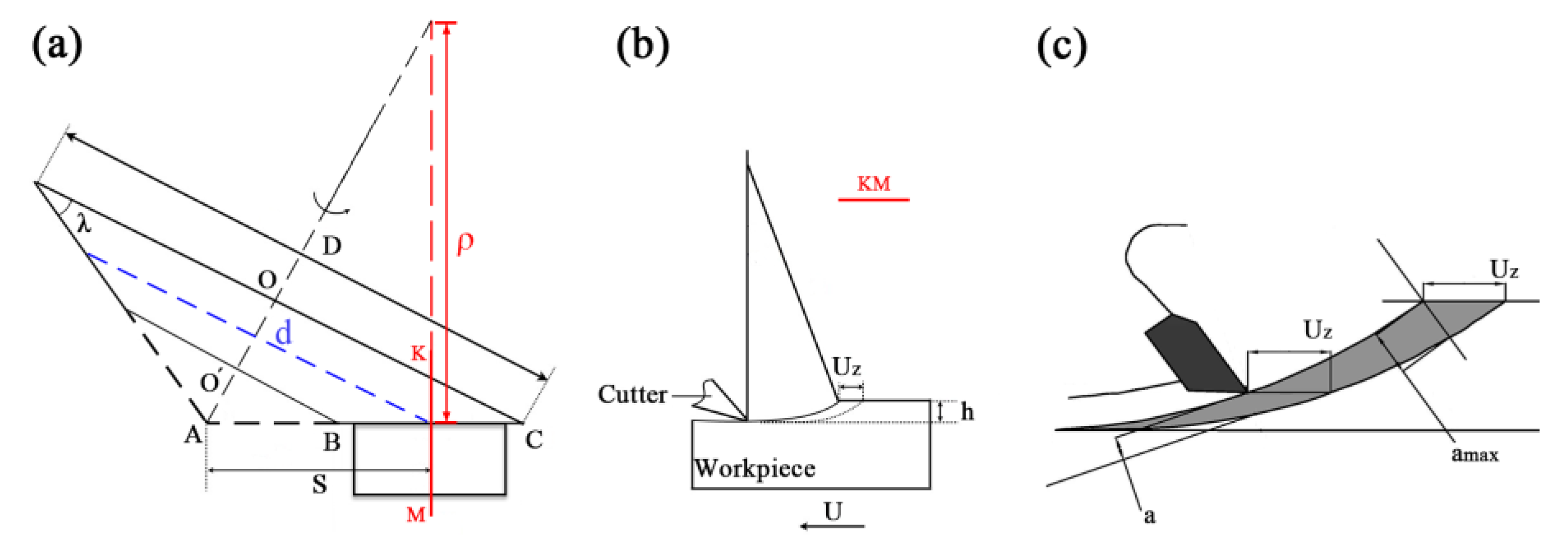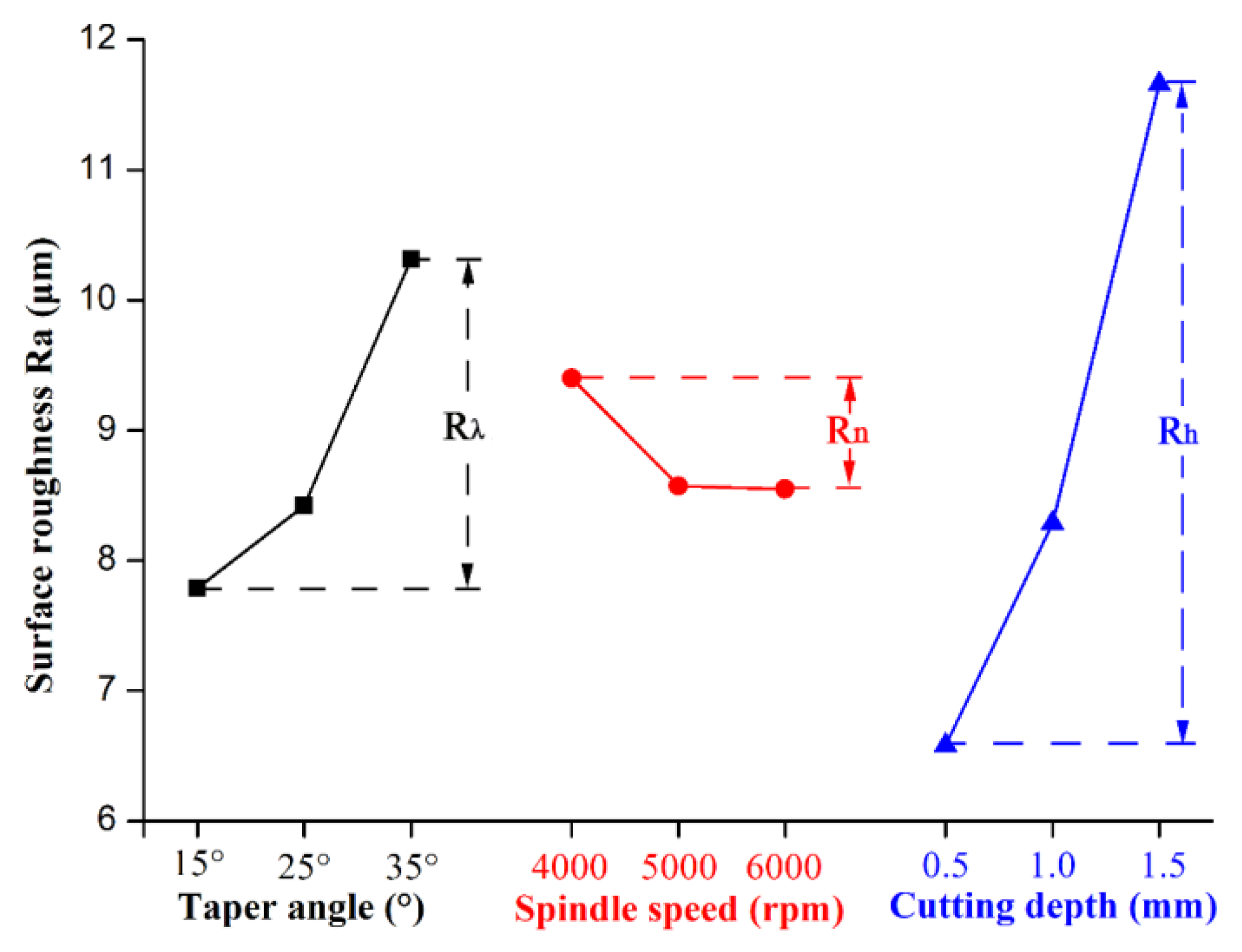3.1. Research on Cutting Force Based on Range Analysis
Table 4 shows the results of the resultant force via range analysis. The larger R values indicate a greater contribution of the factor on the results [
20,
21]. In this work, the solution shows R
h = 33.637 > R
λ = 11.563 > R
n = 2.123. Therefore, factor h (cutting depth) had the greatest influence on the cutting force, followed by factor λ (taper angle), and the factor n (spindle speed) had the least influence on the cutting force. In addition, taking the cutting force as the evaluation index, according to the value of K
i, the optimal combination of the three factors with the lowest cutting force could be selected. It can be concluded that the combination λ
1n
3h
1 was the optimal cutting parameter, in which the taper angle was 15°, the spindle speed was 6000 rpm (43.96 m/s cutting speed, Equation (2)), and the cutting depth was 0.5 mm.
The effects of the taper angle and cutting parameters on the cutting force are displayed in
Figure 3. It was found that the cutting force was enhanced with the increase of the taper angle, decreased slightly with the increase of the spindle speed, and increased with the increase of the cutting depth.
During the tapered milling, shown in
Figure 4a,b, the cutting edge BC was rotated around the OO’ axis to form a tapered surface. By cutting the tapered surface with a plane (KM) perpendicular to the machined surface, the gyration radius, diameter of a point on the cutting edge, and cutting speed can be expressed as Equations (2)–(4), respectively.
where
ρ (mm) is the cutting radius of gyration at any point on the cutting edge BC,
S (mm) is defined as the distance from the apex of the cone to the intercepted point,
λ (°) is the taper angle,
d (mm) is the diameter of a point on the cutting edge BC, and
Vc (m/s) is the cutting speed of a point on the cutting edge BC.
An illustrative sketch of feed per tooth and chip thickness is displayed in
Figure 4c. During cutting, the unwanted material above the cutting layer was removed by the rake angle and formed into chips. The chip volume, namely, removal quantity, was directly determined by feed per tooth and cutting thickness, as expressed by Equations (5) and (6) [
15].
where
Uz (mm) is the feed per tooth,
U is the feed rate with a constant of 15 m/min,
n (rpm) is the spindle speed, and
z is the number of teeth, which was a constant of six in this work.
where
aav (mm) is the average cutting thickness,
amax (mm) is the maximum cutting thickness,
h (mm) is the cutting depth, and
D is the tool radius with a constant of 140 mm.
According to above analysis, the increased taper angle led to a decreased gyration radius and increased cutting speed. The glass MGO board used was an inhomogeneous composite material, having many hard particles. When the cutting edge with a higher speed bit into the glass MGO board, the greater impact force would act on the cutter from the hard particles. Therefore, the cutting force showed a growing trend with the increase of the taper angle of the cutters. Meanwhile, the feed per tooth and average cutting thickness increased with decreasing the spindle speed and increasing the cutting depth. Thus, the cutting quantity per time during milling decreased with the increase of spindle speed, and increased with increasing cutting depth. A larger cutting quantity, indicating higher resistance, was generated during the machining process; therefore, the cutting force decreased with an increase in spindle speed, but increased with an increased cutting depth.
3.2. Research on Cutting Force Based on ANOVA (Analysis of Variance)
ANOVA and F tests were carried out to prove the significance of each factor. As listed in
Table 5, the ANOVA analysis was adopted for a significance level of α = 0.05, namely, 95% confidence level. By comparing the F value of each factor with F
0.05 = 19.00, if the F value of a factor was higher than the value of F
0.05, namely, 19.00, the contribution of that factor was significant, otherwise it was insignificant [
20,
21]. In this work, the contributions of the taper angle (F
0.05 = 19.00 < F
λ = 60.726) and cutting depth (F
0.05 = 19.00 < F
h = 513.136) to the cutting force were significant, while the contribution of the spindle speed was insignificant (F
n = 2.162 < F
0.05 = 19.00).
3.3. Range Analysis of Surface Roughness
Results of the range analysis of the surface roughness are presented in
Table 6. By comparing the R value of each factor, it was found that the R
h value was the largest, and the value of R
n was the smallest (R
h = 5.080 > R
λ = 2.527 > R
n = 0.853). Thus, this result indicates that the cutting depth had the greatest influence on the surface roughness, followed by the taper angle and the spindle speed. Meanwhile, taking the surface roughness as the evaluation index, according to the value of K
i, the optimal combination of the three factors with the lowest value of surface roughness could be selected. Hence, the combination of λ
1n
3h
1 was adopted as the optimal cutting parameter, in which the taper angle was 15°, spindle speed was 6000 rpm (43.96 m/s cutting speed), and the cutting depth was 0.5 mm.
Figure 5 shows the influence of the cutting parameters on the surface roughness, which indicates that the surface roughness increased as the taper angle increased. According to Equation (2) and
Figure 4a,b, with increasing the taper angle, the radius of gyration became smaller. The chip could not easily be removed from the workpiece by the cutter. Therefore, the surface roughness increased with an increasing taper angle. Similar to the results of Guo et al. [
6] and Zhu et al. [
22], the surface roughness decreased with the increase of spindle speed and increased with an increased cutting depth (
Figure 5). As expressed in Equations (5) and (6), the increasing spindle speed and decreasing cutting depth reduced the feed per tooth and the cutting thickness during the milling process, directly lowering the resistance acting on the cutter and improving the cutting stability. Thus, the cutting quality was improved by increasing the spindle speed and decreasing the cutting depth.
3.5. Optimization and Verification
According to the range analysis and the ANOVA of the cutting force and surface roughness (
Table 4,
Table 5,
Table 6 and
Table 7), the optimum cutting combination was λ
1n
3h
1, and cutting speed had an insignificant contribution to both the cutting force and surface roughness. In this case, considering the economic benefit, the spindle speed should be lower but still within an appropriate range, because a lower spindle speed reduces the energy consumption of the machine and causes more severe tool wear. Therefore, the optimal cutting parameters are assumed to be λ
1n
2h
1, in which the taper angle is 15°, the spindle speed is 5000 rpm (36.63 m/s cutting speed), and the cutting depth is 0.5 mm. However, this combination of parameters was not previously performed in the orthogonal test. In order to verify the feasibility of this combination, a verification test was carried out and then compared with a control group, where the lowest cutting force and surface roughness were measured by orthogonal testing.
As shown in
Table 8, when the taper angle was 15°, the spindle speed was 5000 rpm (36.63 m/s cutting speed), and the cutting depth was 0.5 mm, the cutting force and surface roughness were 36.67 N and 5.94 μm, respectively, which are all slightly less than the results of 39.43 N and 6.00 μm acquired by the combination of λ
1n
1h
1. In other words, the optimal cutting parameters assumed are matched and valid. Therefore, during the tapered milling of glass GMO board, the optimum cutting condition is 15° taper angle, 5000 rpm spindle speed (36.63 m/s cutting speed), and 0.5 mm cutting depth, which is proposed for actual machining in order to achieve a smoother machined surface and greater economic benefit.
